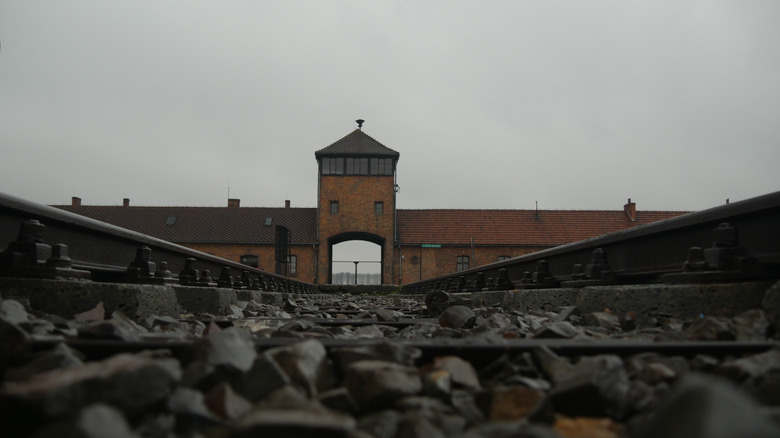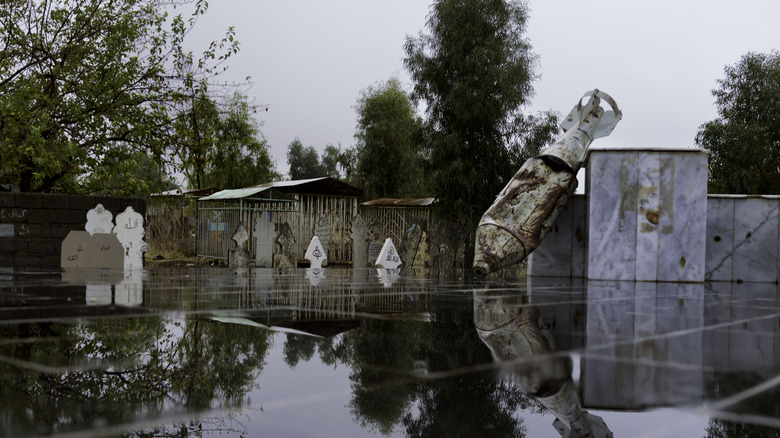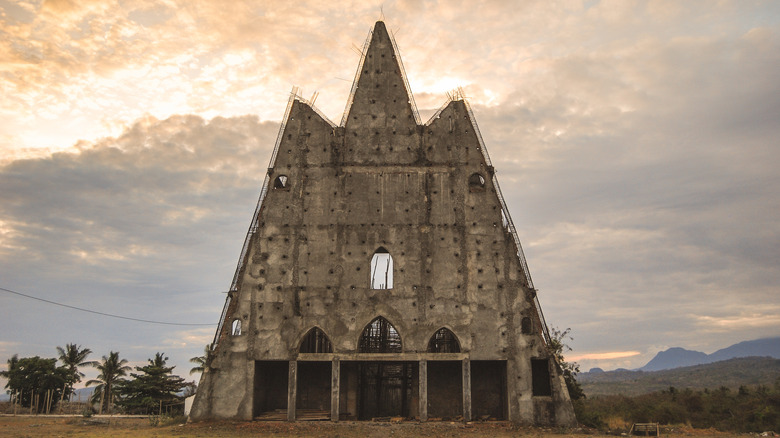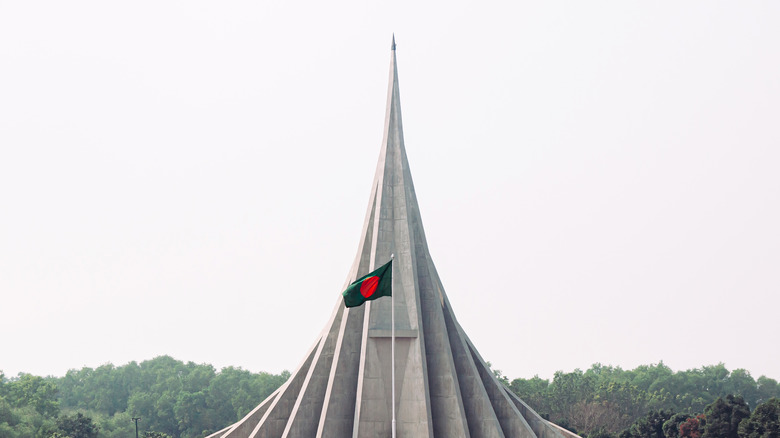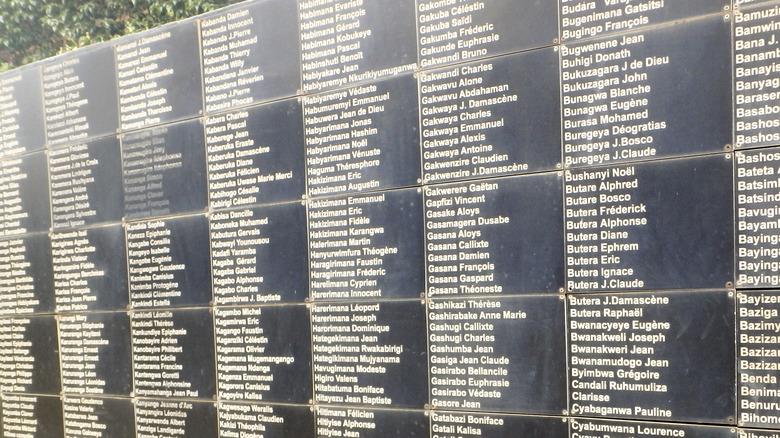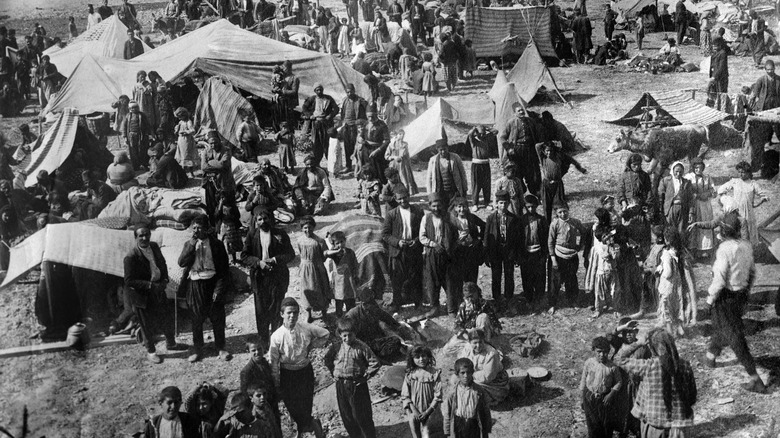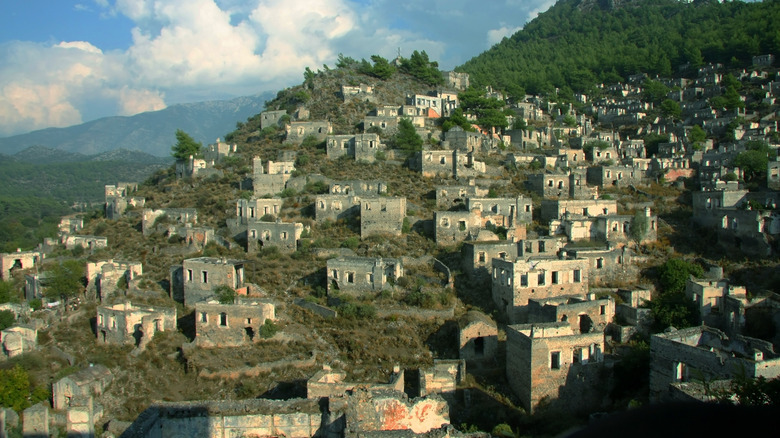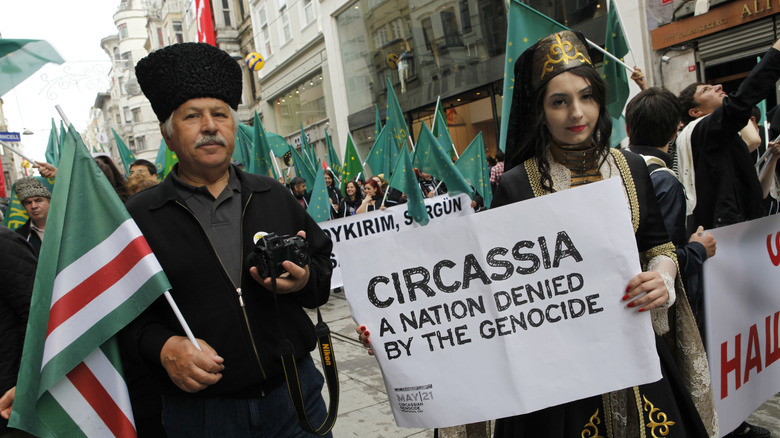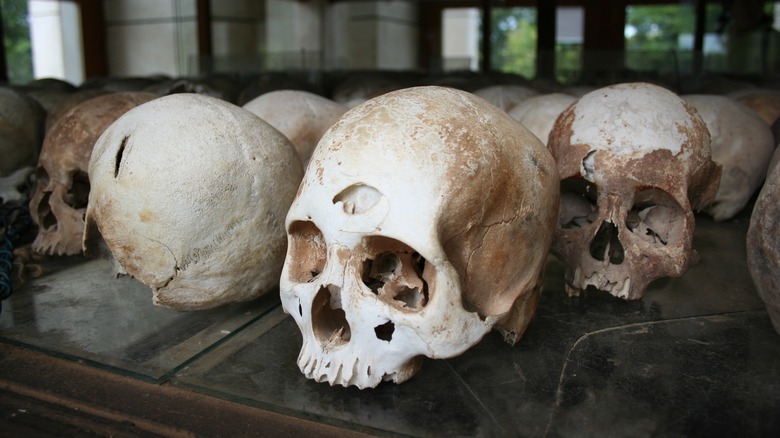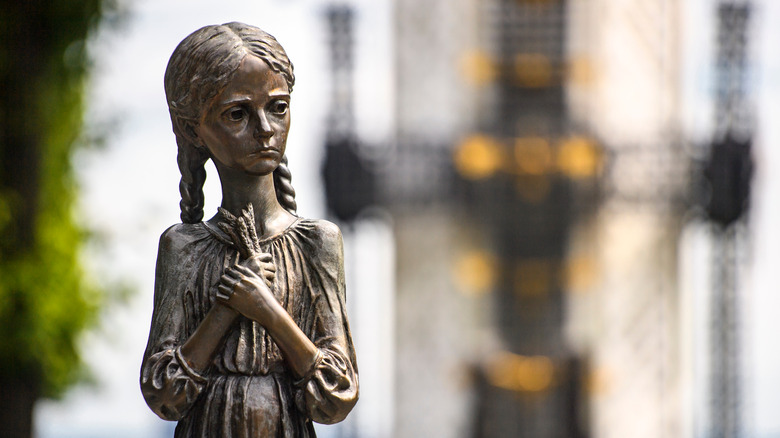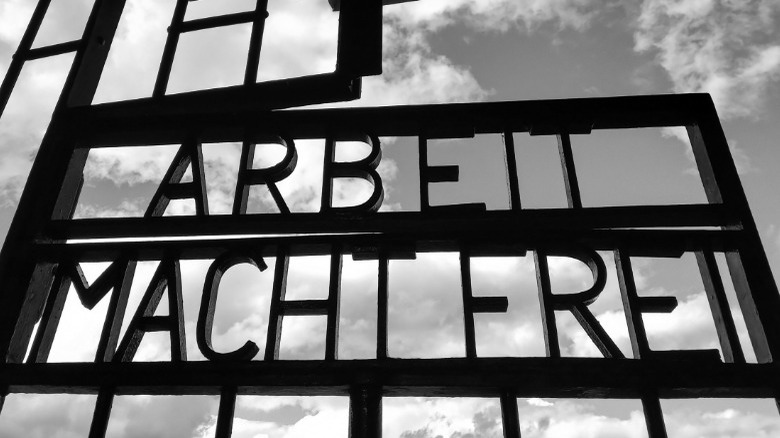The Worst Genocides In History
When the Soviet Union liberated Auschwitz on January 27, 1945, few if any of the soldiers would have realized they were witnessing "genocide." That is because the word had only existed for a matter of months; Polish Jewish lawyer Raphael Lemkin coined the term in 1944, combining "geno-", a Greek word meaning race or tribe, with "-cide", a Latin term meaning "killer" or "act of killing" (via USHMM). Lemkin described genocide as, "A coordinated plan of different actions aiming at the destruction of essential foundations of the life of national groups, with the aim of annihilating the groups themselves."
While the Holocaust prompted the coinage of "genocide," it was neither the first nor the last genocide to occur. These coordinated acts of violence have occurred across the world, from the plains of Ukraine and Cambodia to the jungles of Africa and the hills of the Middle East. Ordered by death toll, here are the worst genocides in history.
Kurdish genocide: 50,000 to 182,000 deaths
The Kurdish genocide, also known as the Anfal campaign, occurred during the Iran-Iraq war, a protracted conflict that lasted from 1980 until 1990 (via Britannica). Kurdistan, a region in the north of Iraq, was governed by two forces loyal to the Iranians – the KDP and the Patriotic Union of Kurdistan. The Kurds' goal was and continues to be the autonomy of Kurdistan, which has been suppressed by neighboring states for centuries, according to The Guardian.
By February 1988, after years of conflict, Iraq's despotic leader Saddam Hussein decided to take extreme measures against the Kurds, who had relative safe havens in the interior beyond the Kurdish cities occupied by Hussein's troops. Over the next nine months, Iraqi forces waged what PBS writer Dave Johns described as, "A mammoth campaign of civic annihilation, displacement and mass killing."
It began with a lethal gas attack that killed hundreds and gave Iraq the distinction of being the first nation to use chemical weapons against its own population. The Anfal – which is Arabic for the "spoils of war" – continued with incessant bombings and ruthless execution directives. During attacks on Kurd villages, it was declared that "All persons captured in those villages shall be detained and interrogated by the security services, and those between the ages of 15 and 70 shall be executed after any useful information has been obtained from them."
The order was followed throughout those nine terrible months. Scores of men, women, and children were rounded up, shot, and dumped in mass graves in places such as Hatra and Samawa. Human Rights Watch estimated the death toll at 50,000 and 100,000, while the Kurds claimed the number to be as high as 182,000.
East Timor genocide: 180,000 to 200,000 deaths
East Timor is a tiny island state in Southeast Asia that shares a landmass with the Indonesian territory of West Timor. A Portuguese colony until the winter of 1975, Indonesia invaded the area when the left-wing Fretilin party declared East Timor an independent state (via BBC). Indonesian forces remained in East Timor for almost 25 years, leaving in 1999 after 78% of the population voted for independence. Consequently, the UN moved into the country and assisted the leadership in building the foundations of statehood.
However, that abridged history neglects to mention the horror of those 24 years; Indonesia's occupation of East Timor wasn't merely oppression – it was genocide. As many as 200,000 people died during the occupation, which was roughly one-quarter of the population. East Timorese died from violence, disease, and manmade famine.
A UN report found that Indonesian forces used starvation as a weapon and even poisoned food and water with napalm and hazardous chemicals. Violence was widespread, too. Death squads executed thousands of people, often with savage cruelty. Around 8,000 witnesses gave macabre testimonies that explained how victims were tortured, mutilated, and sometimes displayed before their horrified families. It was all part of a disgusting strategy to sow terror and hopelessness among pro-independence supporters.
The violence continued until the very end of Indonesia's occupation. After the independence vote in 1999, armed groups tore through the country destroying villages and murdering some 1,500 people. In the years since independence, little justice has been served, with Indonesian generals enjoying "impunity for their crimes against humanity," according to journalist Tom Fawthrop.
Bangladesh genocide: 300,000 to 3 million deaths
In 1971, Dhaka was not the capital of Bangladesh but of East Pakistan, a province of the politically dominant West Pakistan. This was resented by large elements of the Bengali population, who sought to establish their own nation and government. In describing the relations between East and West Pakistan, journalist Paul Dreyfus said, "Over the years, West Pakistan behaved like a poorly raised, egotistical guest, devouring the best dishes and leaving nothing but scraps and leftovers for East Pakistan."
After years of contempt and discrimination toward the Bengali people, tensions came to a head in December 1970 following the election of Sheikh Mujibur Rahman, leader of the Awami League party, which the West Pakistan establishment refused to acknowledge. From March until December of 1971, widespread military violence broke out between Bengalis, Pakistanis, and Indians. Historian Anam Zakaria wrote that the death toll was "between 300,000 and 3 million people."
Much of this death toll was the result of genocide rather than the military conflict. Archer Blood, the American Consul General to Dhaka, wrote that Pakistani soldiers were "systemically eliminating" Bengali independence supporters by "seeking them out in their homes and shooting them down." Blood's testimony was ignored by President Nixon, for whom West Pakistan was an important Cold War ally.
The killings were committed alongside mass rape, which was used not just to terrify and degrade the Bengali people, but to create a generation of "war babies" with West Pakistani blood, according to the Indian Express. The genocide ended on December 16, 1971, with Pakistan's surrender to Indian forces.
Rwandan genocide: 800,000 to 1 million deaths
In 1994, at least 800,000 Tutsis were butchered by Hutu extremists. The Tutsis and Hutus are the main ethnic groups of Rwanda, a country in central Africa. According to National Geographic, the Tutsis comprised 14% of the population in the early 1990s, while the Hutus vastly outnumbered them at some 85% of the populace. Relations between the groups were very poor, with the Tutsis experiencing discrimination and violence since independence from Belgium in 1962.
Thousands of Tutsis fled Rwanda and established themselves in neighboring countries such as Uganda, where Tutsi intelligentsia founded the Rwandan Patriotic Front (RPF), led by Paul Kagame (via Britannica). While Kagame was studying in the United States, the FPR invaded northern Rwanda, which resulted in a power-sharing agreement in 1993.
However, the treaty was never fully realized and, in April 1994, President Juvénal Habyarimana was killed when his aircraft was shot down over Kigali, the nation's capital. The culprits of the attack remain a mystery but, according to the BBC, Hutu military leaders wasted little time in not only blaming the Tutsis but enacting bloody revenge against them.
Over the next 100 days, as many as one million Tutsi and moderate Hutus were killed with machetes and other tools. Roadblocks were set up to prevent families from escaping, often by ordinary Hutu neighbors who showed a disturbing readiness to commit mass murder. The savagery ended when the RPF regrouped and marched into Kigali, causing a mass exodus of Hutus into Zaire, which caused further crises and death (via USHMM).
Armenian genocide: 664,000 to 1.2 million deaths
According to the United States Holocaust Memorial Museum, the Armenian genocide is considered to be the first genocide of the 20th century. It occurred during the First World War, a conflict that would destroy the Ottoman Empire, a once-powerful union that extended across the Middle East and North Africa (via History). With this extension came weakness, as the empire's numerous peoples did not share a common identity and purpose.
This issue was particularly acute in the Armenian region, which had a Christian majority. The Armenian people had long been victims of Ottoman prejudice, who charged them higher taxes than their Muslim neighbors. Despite this, Armenians tended to be wealthier and better educated, which only caused greater animosity among the Muslim majority. As the world was plunged into conflict, the Ottomon leadership feared that the Armenians would defect to an invading army, so a campaign of oppression began on April 24, 1915, which quickly descended into barbarity.
Massacres and deportations were commonplace, with thousands dying by gunshot, starvation, exposure, and disease. "Special organizations" consisting of murderers and ex-convicts were established to murder Armenians in any way they pleased. According to History, these roving gangs of criminals took people from their homes and drowned them, burned them, threw them from cliffs, and even performed crucifixions. The killing was assisted by a "Turkification" program that enslaved women and kidnapped children, giving them to Turkish families. When the genocide ended in 1922, as many as 1.2 million Armenians had been killed or displaced.
Greek genocide: 1 to 1.5 million deaths
Armenians were not the only minority to be fatally persecuted by the Ottoman Empire. At the other end of the territory, in Thrace, Greek communities were ransacked and murdered (via Genocide Watch). The Greeks, like the Armenians, were Christian, and their fate was similarly brutal.
According to the Greek Genocide Resource Center, between 1 and 1.5 million Greeks were the victims of rape, mass murder, death marches, deportations, and torture. Again, many others were kidnapped, too, and these people were forced into the Islamic faith, dumped in labor camps, or tasked with destroying Christian Orthodox monuments and culture.
This terrible injustice continued through the First World War and into the early 1920s, affecting Greek communities across the Ottoman Empire. In 1922, the region of İzmit, which is roughly 60 miles from Istanbul, saw the burning of some 30 Greek villages and the murder of 12,000 people. Particularly egregious was the burning of Smyrna, a punitive act of violence that concluded the Greco-Turkish war, killing thousands of people and leaving the city a smoldering wreck.
The genocide ended diplomatically with the Treaty of Lausanne, which agreed upon a compulsory population exchange between Greece and Turkey. Signed on January 30, 1923, the treaty's legacy is controversial, with historian Norman Naimark describing Lausanne as, "a pivotal international precedent for transferring populations against their will throughout the 20th century."
Circassian genocide: 1.5 million deaths
"Their only crime was not being Russian," remarked Sir Francis Palgrave, a British diplomat who witnessed part of the Circassian genocide, described by UNPO as the first genocide of the 19th century. It was one of the most tragically effective genocides in history, eliminating up to 97% of the Circassian people, who were once the largest ethnic group in the North Caucasus, a region they had inhabited for thousands of years (via ECR Group).
The genocide occurred during the Russo-Circassian war, which lasted from the mid-18th century until May 21, 1864 (via Caucasus Forum). The Russian Empire's objective was to push its border south through the Caucasus mountains, giving Russia greater access to the Black Sea. To achieve this goal, Russian forces employed the terrible hallmarks of genocide – the destruction of food and homes, kidnapping, mass deportation, and summary executions.
This long, grinding genocide created a Circassian diaspora that can be found across Turkey, Russia, and the wider world. Today, they make sure to remember what happened to their people. Tamara Barsik of the "No Sochi" campaign, which opposed the 2014 Sochi games, said, "We are the indigenous people, but we are not part of these Olympics in any shape or form." Another Circassian said the Sochi games were like, "having the Olympics in Auschwitz."
Cambodian genocide: 1.5 to 3 million deaths
In the early 1970s, Cambodia was in the midst of a civil war. The Khmer Rouge, a radical communist party, was making gains across the countryside as it prepared for an attack on Phnom Penh, the nation's capital (via Britannica). Led by dictator Pol Pot, the Khmer Rouge mounted their invasion in the spring of 1975 and took full control of Cambodia on April 17. This day was declared "Year Zero," which posited that Cambodia was born anew and that all existing culture would be destroyed and replaced with an agrarian utopia (via International Business Times).
Over the next four years, Khmer Rouge authorities did their utmost to realize this mad idea. Citizens were removed from their homes and deported to the countryside, where they were forced into farming and hard labor with little training or knowledge. Murder was constant and arbitrary. Anyone suspected of even the slightest resistance faced torture or death. Those considered to be intellectuals were among the first to die in the killing fields. One didn't need to hold a degree to be considered an intellectual – just wearing a pair of glasses was evidence enough.
By 1979, as many as 2 million people were dead, either by disease, starvation, slave labor, or blunt force trauma. This toll represented one-fifth of Cambodia's population, according to historian Ben Kiernan. Pol Pot's twisted fantasy came to an end when Vietnam invaded Cambodia on January 7, 1979. Nayan Chanda wrote how the Vietnamese faced little resistance in their dash to Phnom Penh, which was a ghostly shell of a city. After years in exile, Pol Pot died on April 15, 1998, having never faced justice.
Holodomor: 3.9 to 5 million deaths
From 1932 to 1933, the Soviet Union brutally collectivized agriculture in Ukraine, forcing scores of peasants to submit to a communistic style of farming in which food was confiscated and no land or property was to be owned (via Britannica). The result was a wholesale failure: reduced production, chaotic supply chains, and dire food shortages. Death followed on a terrible scale. Some 3.9 million Ukrainians perished, while a further 1 million died in other parts of the USSR, namely Kazakhstan.
The horrors of this manmade famine were exposed on the world stage by Gareth Jones, a Welsh journalist. The brave 27-year-old witnessed firsthand just how desperate the people of Ukraine were. "We are ruined," one villager told Jones, "We are the living dead" (via BBC). According to History Extra, villagers were forced to eat bark, grass, hay, and pinecone soup. All animals – from chickens and wild birds to dogs and cats – were consumed as the peasants became increasingly desperate. Eventually, they started to eat each other, taking strips of flesh from those who had perished.
The Holodomor was denied not only by Josef Stalin's regime but by Western journalists, too. Pulitzer prize-winning writer Walter Duranty, who was based in Moscow and granted special hedonistic perks by the Soviets, described accusations of famine as "malicious propaganda," adding that "Mr. Jones's judgment was somewhat hasty." Gareth Jones would be murdered during an assignment in Mongolia on August 12, 1935. It is suspected that the Soviets were involved in the journalist's death.
The Holocaust: 11 million deaths
The Holocaust was the endgame of Nazi racial ideology, which dictated that Aryans were superior to all other races, especially Jews, who were considered to be dangerous political operators (via Holocaust Encyclopedia). When Hitler assumed dictatorial powers on August 2, 1934, the Nazi government implemented policies that would result in the industrial murder of millions.
It started with the exclusion of Jews from all sectors of German life, which was mandated by the Nuremberg Laws and enforced by paramilitary thugs of the SA and SS. Then, in a rapid escalation of prejudice, the Nazi state unleashed a wave of terror on November 9-10, 1938. Around 100 Jewish people were murdered as synagogues, homes, schools, and businesses were ransacked and destroyed, strewing glass and detritus across the streets in what would be known as Kristallnacht – the Night of Broken Glass.
By the start of the Second World War in September 1939, German Jews were forced to wear armbands in public and faced arbitrary detention in places such as Dachau, the first Nazi concentration camp (via History). When the Nazi state occupied countries across Europe, the Holocaust entered its final, terrible stages.
Jews, gypsies, Slavs, homosexuals, and others considered "Untermenschen" were either killed or deported to ghettos and concentration camps, where they lived in horrendous squalor. The genocide was particularly brutal in the east, which saw Einzsatsgruppen death squads execute 1.5 million civilians in the early 1940s. By 1942, however, the Nazi state used not lead but poison gas chambers to achieve the "Final Solution of the Jewish Question." Death camps such as Belzec, Treblinka, and Auschwitz killed 500,000, 925,000, and 1.1 million people, respectively. When Mauthausen was liberated on May 5, 1945, the Nazi genocide had killed approximately 11 million people, 6 million of them Jews (via USHMM).
